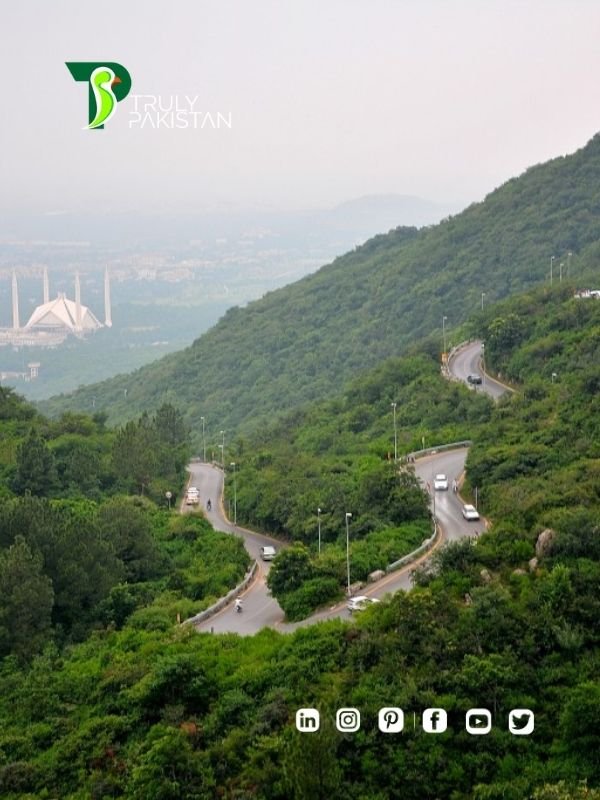The Complete Guide to Hiking Margalla Hills: Trails, Safety, and Everything You Need to Know
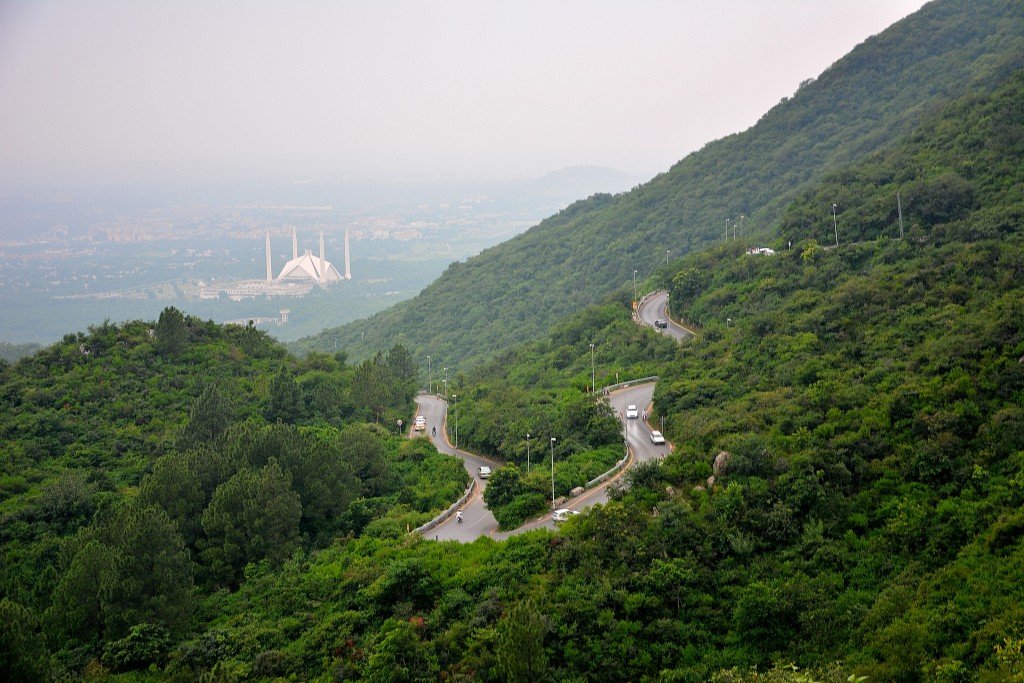

Agree: If you’re looking for the perfect outdoor escape near Islamabad, hiking Margalla Hills is likely at the top of your list. The trails are close to the city yet feel worlds away—offering greenery, wildlife, and sweeping views of Pakistan’s capital.
Promise: This guide will walk you through everything you need to know about hiking Margalla Hills—from comparing trails and planning the best time to visit, to safety tips, gear checklists, and even cultural highlights along the way.
Preview: By the end, you’ll have a complete, step-by-step roadmap that makes your hiking trip safe, enjoyable, and memorable. Let’s dive in.
Table of Contents
Why Hiking Margalla Hills Should Be on Every Adventurer’s List
Pakistan’s Premier Urban Wilderness Experience
Margalla Hills are a rare gift—an accessible hiking destination located just minutes from the heart of Islamabad. Covering more than 17,000 hectares, the park offers a mix of rugged trails, serene viewpoints, and diverse wildlife. Unlike other hiking spots that require long drives, Margalla Hills make adventure possible even for those with just half a day to spare.
Unique Himalayan Foothill Ecosystem
Part of the Himalayan foothills, the Margalla range is home to over 600 plant species, 250 bird species, and nearly 40 species of mammals, including the elusive Asian leopard. This biodiversity makes hiking Margalla Hills more than just a workout—it’s an encounter with one of Pakistan’s richest natural environments.
Rich Cultural and Historical Heritage
These hills don’t just tell a story of nature—they’re woven into Pakistan’s cultural fabric. From the ancient Shah Allah Ditta caves to panoramic views of Faisal Mosque, hiking Margalla Hills offers a combination of outdoor adventure and a glimpse into centuries of heritage. For many, it’s this blend of culture and wilderness that makes the trails unforgettable.
Quick Checklist: Why People Choose Hiking Margalla Hills
✔️ Accessibility Trailheads just 10–20 minutes from central Islamabad. ✔️ Diversity Options for beginners, intermediate hikers, and experts. ✔️ Scenic Views Overlooks of Islamabad, Faisal Mosque, and the Himalayan foothills. ✔️ Cultural Spots Historic caves, villages, and viewpoints along the routes.
Complete Margalla Hills Trail Comparison and Selection Guide
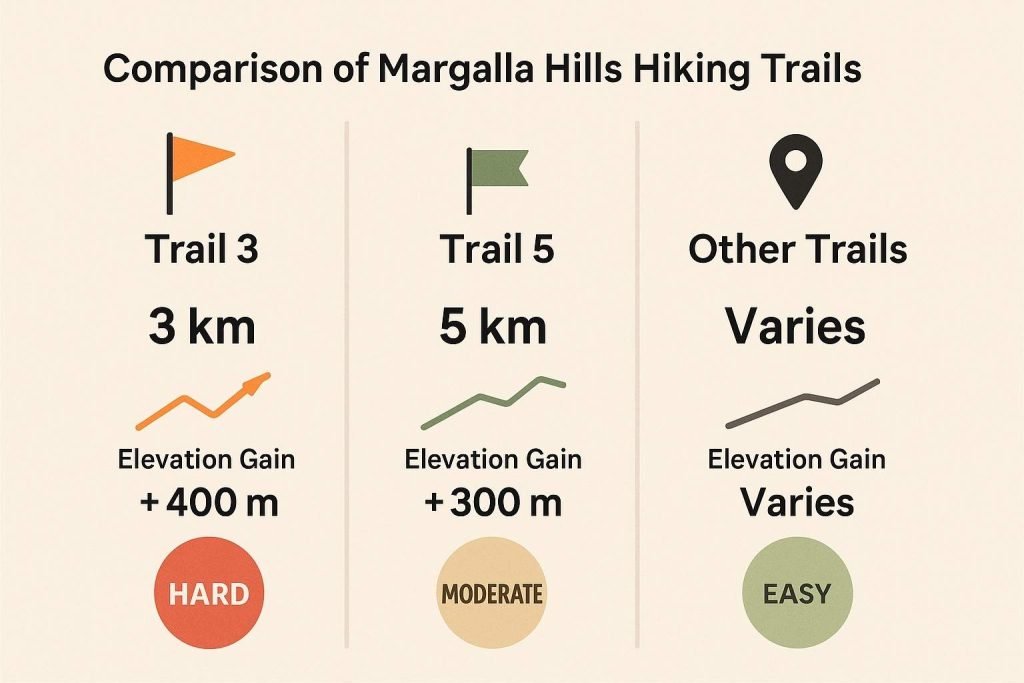

Trail Difficulty Matrix for Hiking Margalla Hills
Choosing the right trail is the first big decision for hikers. Margalla Hills feature six main trails, each with its own length, elevation, and difficulty level. Below is a simplified breakdown:
- Trail 1 & 2: Shorter, moderate climbs with scenic forest cover.
- Trail 3: Around 5.7 km with 615 m elevation gain—popular but physically demanding.
- Trail 5: About 7 km with gentler slopes—great for longer, scenic hikes.
- Trail 6: Known for its bird loop and ridge sections, suited for enthusiasts seeking solitude.
This matrix makes it easier for beginners, families, and fitness seekers to choose the right starting point.
Trail 3: The Classic Margalla Hills Hiking Experience
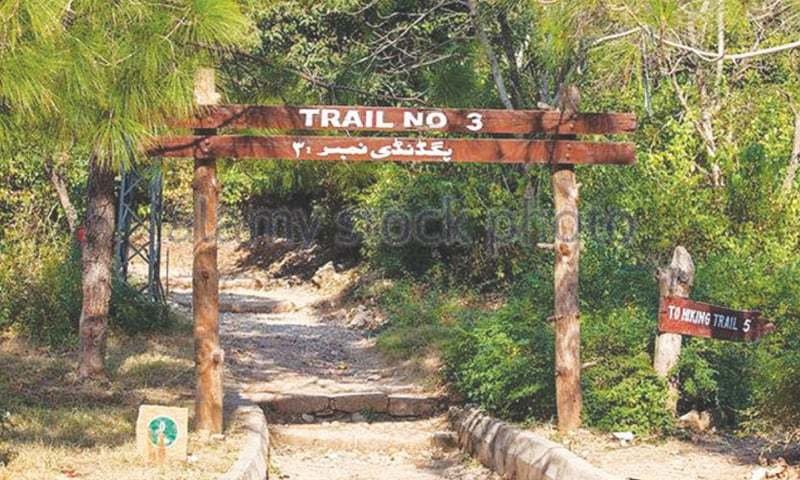

Looking for a direct, rewarding climb? Trail 3 is your go-to. It’s a sustained ascent with switchbacks, forest cover, and stellar viewpoints—perfect if you want a solid workout while hiking Margalla Hills.
- Distance & Elevation: ~5.7 km; ~615 m gain (source)
- Time: 2–3.5 hours round trip (fitness dependent)
- Difficulty: Moderate to challenging (steep in places)
- Best for: Fit beginners, intermediates, time-boxed hikers
- Start: Sector F-6 trailhead; Finish: Ridge near Pir Sohawa road
Pro tip: Start early to beat the heat and crowds. Carry at least 1.5–2L water per person.
Trail 5: The Scenic Margalla Hills Adventure Route
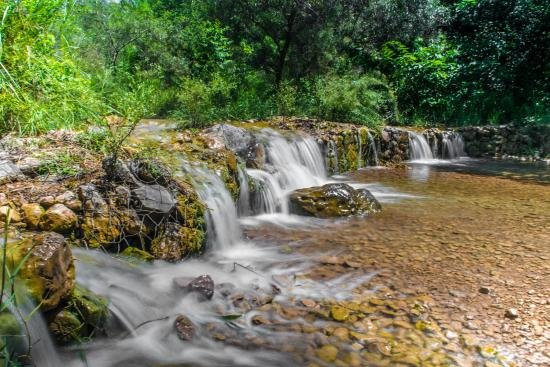

Prefer gentler gradients, longer forest walks, and streamside sections? Trail 5 delivers. It’s a crowd favorite for families and photographers hiking Margalla Hills.
- Distance & Elevation: ~7 km; gentler cumulative gain (source)
- Time: 2.5–4 hours round trip
- Difficulty: Easy to moderate
- Best for: Beginners, families, casual hikers, nature photography
- Start: Trail 5 parking area (F-5/F-6 side); Finish: Connects toward Trail 3 ridgelines
Heads up: Stream sections can be slippery after rain. Wear grippy footwear.
Lesser-Known Trails for Hiking Margalla Hills
- Trail 6: Bird loop and ridge segments; quieter, great for birders and sunrise hikers (overview).
- Trails 1 & 2: Shorter approaches with shaded stretches; good conditioning hikes.
- Margalla Ridge Trail: Long, undulating traverse with big views; for experienced hikers (route ref).
| Metric | Trail 3 | Trail 5 |
|---|---|---|
| Distance | ~5.7 km | ~7 km |
| Elevation Gain | ~615 m (steeper) | Gentler cumulative |
| Best For | Workout, time-boxed ascent | Families, photo ops, longer wander |
| Crowds | High (popular) | High on weekends |
Essential Safety Protocols for Hiking Margalla Hills
Leopard Safety Guidelines for Margalla Hills Hikers
Yes—leopards live here. Encounters are rare, but preparedness matters.
- Hike in groups; keep children close. Avoid dawn/dusk when big cats are most active (IWMB guidance).
- Stay on marked trails; do not follow animal paths or cut through dense brush.
- If you see a leopard: stay calm, make yourself look bigger, maintain eye contact, back away slowly. Do not run.
- Keep noise conversational to avoid surprising wildlife. No feeding or approaching animals—ever.
- Report sightings to park authorities via the IWMB contact portal.
Bottom line: Respect distance, keep situational awareness, and you’ll be fine.
Weather Awareness and Monsoon Precautions
Flash showers can turn dry gullies into streams—fast. Plan around weather when hiking Margalla Hills.
- Check the official forecast before you go (Pakistan Meteorological Department).
- Avoid heavy-rain days (July–September monsoon). Postpone if a cloudburst is likely.
- After rain: expect slick rock, mud, and minor washouts. Trek poles help on descents.
- Pack a light rain shell, dry bag for phone, and extra socks.
Emergency Procedures and Contact Information
- If injured: Move to safe ground, apply basic first aid, and call emergency services (Rescue 1122). Share a pin from your phone.
- Lost or off-route: Stop, reorient with an offline map (download ahead), and backtrack to the last known marker.
- Heat & dehydration: Sip steadily, rest in shade, and cool down. Turn back early if dizziness or cramps begin.
- Authority links: Trail notices & closures—Capital Development Authority; Wildlife & safety—IWMB.
Pro move: Share your plan and ETA with a friend; check in when you’re back at the trailhead.
Optimal Timing and Conditions for Hiking Margalla Hills
Best seasons for hiking Margalla Hills
October–April offers cooler, clearer days and excellent visibility. Late May–September brings heat and monsoon instability—great greenery, but higher slip and flash-flood risk. In winter, mornings can be cold; afternoons are crisp and ideal for views.
- Peak comfort: Nov–Feb (cool, low humidity, crisp vistas)
- Wildflowers & green hills: Mar–Apr (watch for pollen and bees)
- Monsoon caution: Jul–Sep—check forecasts and trail advisories before hiking (Pakistan Meteorological Department).
Ideal daily timing for hiking Margalla Hills
Start early. Aim to be on-trail at sunrise for cooler temps, fewer crowds, and wildlife sightings from a safe distance.
- Best start: Dawn–9:00 am; or after 4:30 pm outside leopard active windows.
- Avoid: Midday heat (dehydration risk) and dusk/dawn in leopard zones—follow IWMB guidance.
- Turnaround time: Set a hard turnaround to exit before dark without rushing.
Weather considerations for hiking Margalla Hills
Conditions can change quickly in the foothills. Plan for sun, wind on ridges, and sudden showers.
- Download an offline forecast snapshot and radar image before you go.
- After rain, expect slick rock and temporary stream crossings—trekking poles help.
- Heat rule: if you stop sweating or feel dizzy, rest in shade, hydrate, and reassess.
Complete Gear and Preparation Guide for Margalla Hills
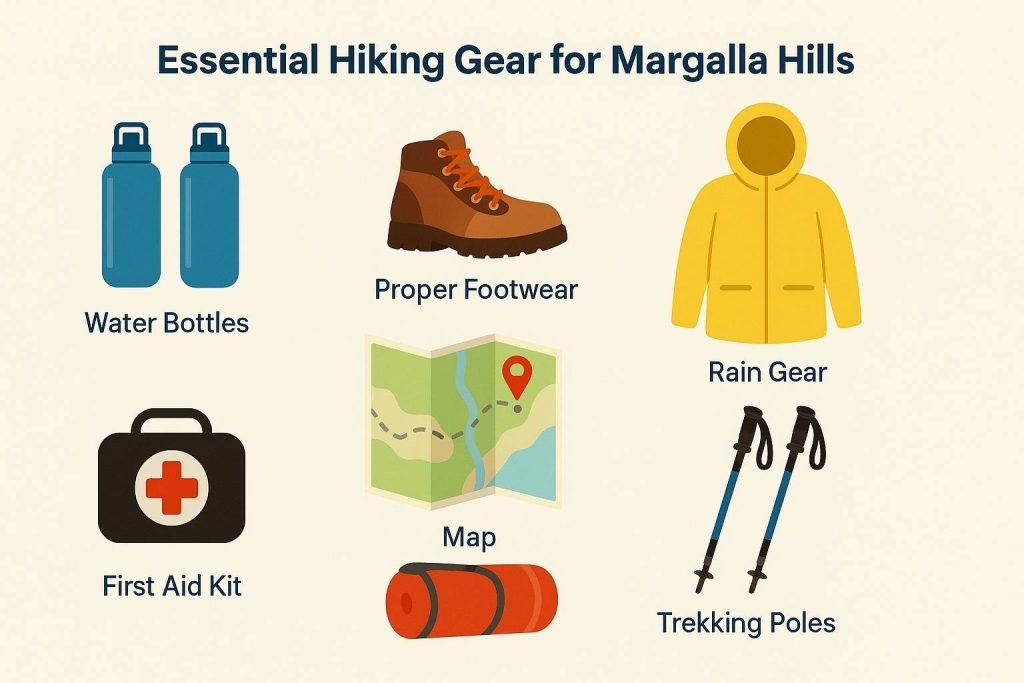

Essential equipment for hiking Margalla Hills safely
- Footwear: Trail shoes with grippy outsole; ankle support for rocky sections.
- Hydration: 1.5–2 L per person for Trail 3; 2–2.5 L for Trail 5 (hot days add +1 L).
- Navigation: Offline map (phone + power bank) and a basic compass.
- Safety: Whistle, mini first-aid kit, headlamp (even for daytime, just in case).
- Sun & bugs: Hat, SPF 50, sunglasses, light insect repellent.
Clothing recommendations for Pakistan’s climate
- Layering: Lightweight, moisture-wicking base; pack a wind shell for ridges.
- Monsoon kit: Quick-dry shirt/shorts and compact rain jacket.
- Winter add-ons: Light fleece and gloves for dawn starts.
Navigation tools and emergency supplies for hiking Margalla Hills
Offline maps Download area tiles before arrival; cell coverage can drop in gullies. Shared itinerary Tell a friend your trail choice, start time, and ETA; check in post-hike. Emergency contacts Rescue 1122; closures & notices via CDA and IWMB.
Frequently Asked Questions About Hiking Margalla Hills
Which trail is best for beginners when hiking Margalla Hills?
Trail 5 is typically the most beginner-friendly for its gentler gradients and shaded stretches. Fit first-timers who want a shorter, steeper workout often choose Trail 3. For quieter mornings, consider Trail 6 (bird loop) and turn around before ridge exposure.
How long does it take to hike Trail 3 when hiking Margalla Hills?
Most hikers complete Trail 3 in 2–3.5 hours round-trip, depending on fitness, breaks, and photo stops. Steep sections and heat can add time—start early and pace yourself.
Is it safe to hike alone when hiking Margalla Hills?
Group hiking is safer. If you must go solo, start at dawn, stick to marked paths, share your plan, and avoid dawn/dusk in leopard areas. Keep situational awareness and don’t wear earbuds; follow IWMB safety guidance.
What time is best for hiking Margalla Hills?
Sunrise to mid-morning offers cooler temperatures, fewer crowds, and clearer views. In winter, late morning is also excellent. Avoid hiking after dusk.
Are there leopards on the trails when hiking Margalla Hills?
Yes, leopards inhabit the park, but encounters are rare. Hike in groups, make steady noise, keep children close, and do not run if you spot one—back away slowly while facing the animal. Report sightings to authorities via IWMB.
What should I bring for hiking Margalla Hills?
- Grippy trail shoes, sun protection, 1.5–2.5 L water, snacks/electrolytes
- Offline map + power bank, whistle, small first-aid kit, light shell
- Cash for post-hike snacks/transport and an ID
Cultural and Historical Highlights Along Margalla Hills Trails
Shah Allah Ditta Caves: Ancient Buddhist Heritage
On the western side of the Margalla Hills lie the Shah Allah Ditta caves, dating back more than 2,400 years. These caves were used by Buddhist monks for meditation, and remnants of murals can still be spotted. Today, they serve as a quiet cultural stop for hikers seeking more than just nature while hiking Margalla Hills.
Saidpur Village: Living History Experience
Nestled against the foothills, Saidpur Village blends history, religion, and modern cafes. The village features preserved Hindu temples, Sufi shrines, and colonial-era buildings. For hikers, it’s an excellent pre- or post-trail detour to add cultural depth to their Margalla Hills adventure.
Faisal Mosque Views from Hiking Margalla Hills
Few things compare to the panoramic sight of Faisal Mosque’s white marble minarets rising from Islamabad’s greenery. Both Trail 3 and Trail 5 offer lookout points where hikers can capture postcard-worthy shots. It’s a reminder of how nature and architecture coexist in Pakistan’s capital.
Transportation and Logistics for Hiking Margalla Hills
Getting to Margalla Hills Trailheads
Trailheads are only 15–20 minutes from central Islamabad. The most common starting points:
- Trail 3: Accessible from Sector F-6 parking lot
- Trail 5: Entry near F-5/F-6 area with designated parking
- Trail 6: Near Faisal Mosque and Daman-e-Koh junction
Hikers without a car can use ride-hailing apps or taxis. Public transport is limited directly to trailheads, so plan ahead.
Parking Options and Public Transportation
Designated parking is available at Trail 3 and Trail 5 trailheads. Arrive early on weekends to secure a spot. For those without cars:
- Ride-hailing apps: Uber, Careem, InDrive—common and inexpensive.
- Taxis: Widely available near Blue Area and F-6 markets.
Post-Hike Dining and Cultural Experiences
After your hike, reward yourself with Islamabad’s hilltop restaurants:
- Monal Restaurant: Famous for panoramic city views and Pakistani cuisine.
- La Montana: Scenic dining with continental and desi menus.
- Cafés in Saidpur Village: A blend of history and modern hospitality.
Wildlife and Conservation in Margalla Hills
Biodiversity of the Margalla Hills Ecosystem
Margalla Hills host over 600 plant species, 250+ birds, and mammals like gray goral, barking deer, wild boar, monkeys, and the critically important Asian leopard. Birdwatchers often spot partridges, woodpeckers, and even migratory falcons. Hiking here means stepping into a living ecosystem.
Responsible Hiking Practices
- Stay on marked trails to reduce erosion.
- Carry out all trash; do not litter.
- Avoid loud music—let others enjoy the wilderness.
- Do not feed monkeys or wild animals.
Supporting Conservation Efforts
The Islamabad Wildlife Management Board (IWMB) manages the park. Hikers can help by respecting rules, reporting illegal logging or hunting, and supporting local eco-tours. Every responsible step ensures that hiking Margalla Hills remains sustainable for future generations.
Conclusion: Your Margalla Hills Hiking Adventure Awaits
Margalla Hills are more than just trails—they’re a living blend of nature, history, and culture. Whether you’re a beginner taking on Trail 5 or an adventurer tackling Trail 3, hiking here offers a memorable experience right in Islamabad’s backyard. With the right preparation, safety mindset, and respect for the environment, every hike becomes a story worth telling.
CTA: Ready to plan your trip? Download our free printable trail map and safety checklist before you go.
About the Author
Author: ZunNurain Khalid — Travel & Tourism Specialist, Founder of ExploreX Pvt. Ltd., and advocate for sustainable tourism in Pakistan. With over a decade of experience in digital marketing and destination branding, ZunNurain has worked extensively on promoting Pakistan’s natural and cultural heritage.

